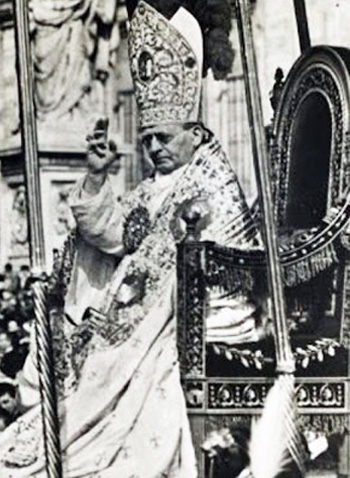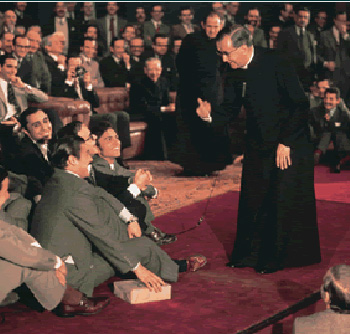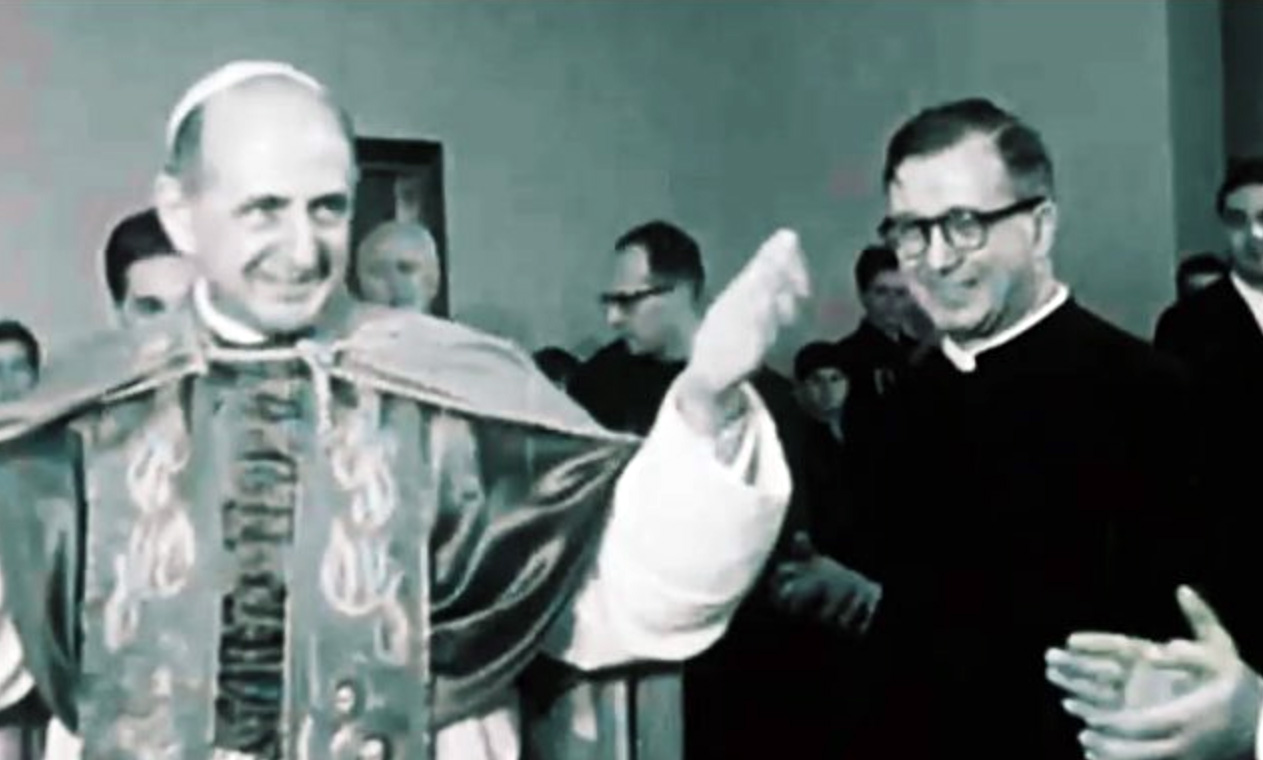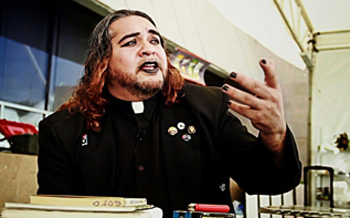Traditionalist Issues
 |
 |
 |
 |
 |
 |
 |
Dialogue Mass - CXIII
Greater Holiness Required of the Clergy
As a result of the new theology of Vatican II, the traditional understanding of the priesthood as a supernatural calling requiring a higher degree of holiness than that of the ordinary faithful has either diminished, or disappeared or become relativized.
The Council only mentions the ordained priest’s specific call to holiness in the context of all the baptized – religious or lay – who have a general obligation to strive for holiness in their lives. But it carefully refrains from saying whether this “special” vocation constitutes a higher form of holiness than that required from any other state of life in the Church.
 The discrepancy between Vatican II and the traditional teaching is starkly portrayed in Pius XI’s Encyclical Letter to Catholic Priests. Quoting St. Thomas Aquinas, the Pope stated:
The discrepancy between Vatican II and the traditional teaching is starkly portrayed in Pius XI’s Encyclical Letter to Catholic Priests. Quoting St. Thomas Aquinas, the Pope stated:
“To fulfil the duties of Holy Orders, common goodness does not suffice; but excelling goodness is required; that they who receive Orders and are thereby higher in rank than the people, may also be higher in holiness.” (1)
St. Thomas Aquinas tells us as well that a man who is appointed to the most august ministry of serving Christ Himself at the altar requires greater interior sanctity than that which is requisite even for the non-ordained religious state. (2)
Thomas à Kempis said that as the priest is “consecrated to celebrate Mass,” he is “bound by stricter discipline and held to more perfect sanctity.” (3) This requirement, incidentally, applies in varying degrees to clerics in Minor Orders and the Sub-Diaconate, for they partake of the graces necessary for their journey to the priesthood.
Therefore, the 1917 Code of Canon Law declared that “Clerics must lead a life, both interior and exterior, more holy than the laity, and be an example to them by excelling in virtue and good works.” (4)
The issue, it should be emphasized, is not and never has been whether an individual cleric achieves greater holiness than an individual layman, but what the Church has taught us about the nature of the clerical state and its relationship with the Eucharist.
Reversal of meanings, values & attitudes
After Vatican II, the “higher holiness” of the clergy suddenly became a taboo subject, cast into the outer darkness, to be replaced by the slogan “the universal call to holiness” found in Lumen gentium.
It would soon transpire that this did not convey the traditional meaning that all the baptized, no matter what their status in the Church, should strive for perfection in the Christian life. It was, instead, used in the sense of “equality of holiness for all,” and was weighted against those who had the most to lose by a demotion from their higher status, that is, clerics in Minor and Major Orders.
Reversing the received and accepted teaching of the Church on the necessity of higher holiness for the ordained, Pope John Paul II stated: “Indeed the ministerial priesthood does not of itself signify a greater degree of holiness with regard to the common priesthood of the faithful.” (5)
This statement is an explicit contradiction of the common witness of the Church up to Vatican II that set all clerical orders above the lay state in terms of the holiness of their office in proportion as they drew more closely to the priesthood of Christ. Coming from the Pope, it is morally indefensible for, by equalizing the clerical and lay states, he indirectly degraded the Petrine ministry for which the title His Holiness was given in recognition of the pre-eminent holiness of his office.

 The idea, however, of deflating the higher status of the priesthood did not originate with John Paul II even though he successfully intervened, as we shall see later, at Vatican II to introduce it into Lumen gentium when he was a young Bishop. A dangerous precedent had already been set by the founder of Opus Dei, Msgr. Josemaría Escrivá, who wrote in 1945:
The idea, however, of deflating the higher status of the priesthood did not originate with John Paul II even though he successfully intervened, as we shall see later, at Vatican II to introduce it into Lumen gentium when he was a young Bishop. A dangerous precedent had already been set by the founder of Opus Dei, Msgr. Josemaría Escrivá, who wrote in 1945:
“Both priests and laymen, by reason of the one baptism they have received, must equally aspire to sanctity… the sanctity to which they are called is not greater in the priest than in the layman, since the latter is not called to be a second class Christian. Holiness, both in the priest and the layman, is nothing other than the perfection of Christian life.” (6)
The implication here is that Ordination does not elevate the priest to a higher spiritual rank or degree of sanctity than the laity. But this is diametrically opposed to the Church’s established teaching, and clashes head on with what Pius XI had stated only a few years previously in his aforementioned Encyclical on the Catholic Priesthood.
So Msgr. Escrivá’s vision for the Church and his organization is not consistent with the Catholic conception of the priesthood. It was an intellectual construct typical of 20th-century progressivist theological innovators who wanted to promote “active participation” of the laity as the highest principle.
His innuendo that the layman was treated as a “second class Christian” in the Church was part of their revolutionary thought process and is imbued with a neo-Marxist tone. It suggests that the non-ordained masses are the victims of unfair discrimination by the ordained (the privileged few). It was a disguised form of “liberation theology” that could be aptly termed “preferential option for the laity.”
However, in a message sent by the Vatican in 2013 to Opus Dei lauding its founder’s contribution to theology, Pope Francis dubbed Escrivá “a precursor of Vatican II in stressing the universal call to holiness.” (7)
The new slogan: 'the universal call to holiness'
The Church has always stressed the necessity for all Christians without exception to work towards spiritual perfection – an imperative based on Our Lord’s teaching (Matt. 5:48). But in the hands of theological innovators this passage of Holy Scripture became an ideological weapon in maintaining the fantasy that there is no higher sanctity attached to the priesthood.

 Obvious negative consequences flowed from the wide dissemination of this slogan in a sense unfavorable to the clergy. If Ordination does not elevate the priest to a higher degree of holiness than the lay state, then his essential nature as minister of the sacred is degraded to the level of all the baptized.
Obvious negative consequences flowed from the wide dissemination of this slogan in a sense unfavorable to the clergy. If Ordination does not elevate the priest to a higher degree of holiness than the lay state, then his essential nature as minister of the sacred is degraded to the level of all the baptized.
In other words, the “universal call to holiness” was a slogan with the potential to diminish the reverence due to the priest by compounding his higher level of holiness into a homogeneous mass of holiness for all, thus allowing the particular to be submersed in the collective and, eventually, lost from view.
From there it was but a short step to Vatican II’s promotion of lay “active participation” and the liturgical and ecclesiastical revolution of the post-Vatican II era. The intention of the progressivists was that, on the empirical level at least, the ministerial priesthood must no longer be distinguished from the common priesthood of the faithful. As a result, all that was held as sacred about the priesthood has been dragged down to a common and profane level, to adapt it to the worldly spirit of the times.
What was once believed on this subject by Catholics of previous centuries – that greater holiness befits the clerical than the lay state – has become darkened and eclipsed by the novel teachings of Vatican II. And, consequently, any attempt to reiterate the traditional doctrine is censored, as it would now be at odds with the official, politically correct mindset of “equality of holiness” for all.
Continued

The Council only mentions the ordained priest’s specific call to holiness in the context of all the baptized – religious or lay – who have a general obligation to strive for holiness in their lives. But it carefully refrains from saying whether this “special” vocation constitutes a higher form of holiness than that required from any other state of life in the Church.

Pius XI's traditional papal teaching
called the priest to greater holiness
“To fulfil the duties of Holy Orders, common goodness does not suffice; but excelling goodness is required; that they who receive Orders and are thereby higher in rank than the people, may also be higher in holiness.” (1)
St. Thomas Aquinas tells us as well that a man who is appointed to the most august ministry of serving Christ Himself at the altar requires greater interior sanctity than that which is requisite even for the non-ordained religious state. (2)
Thomas à Kempis said that as the priest is “consecrated to celebrate Mass,” he is “bound by stricter discipline and held to more perfect sanctity.” (3) This requirement, incidentally, applies in varying degrees to clerics in Minor Orders and the Sub-Diaconate, for they partake of the graces necessary for their journey to the priesthood.
Therefore, the 1917 Code of Canon Law declared that “Clerics must lead a life, both interior and exterior, more holy than the laity, and be an example to them by excelling in virtue and good works.” (4)
The issue, it should be emphasized, is not and never has been whether an individual cleric achieves greater holiness than an individual layman, but what the Church has taught us about the nature of the clerical state and its relationship with the Eucharist.
Reversal of meanings, values & attitudes
After Vatican II, the “higher holiness” of the clergy suddenly became a taboo subject, cast into the outer darkness, to be replaced by the slogan “the universal call to holiness” found in Lumen gentium.
It would soon transpire that this did not convey the traditional meaning that all the baptized, no matter what their status in the Church, should strive for perfection in the Christian life. It was, instead, used in the sense of “equality of holiness for all,” and was weighted against those who had the most to lose by a demotion from their higher status, that is, clerics in Minor and Major Orders.
Reversing the received and accepted teaching of the Church on the necessity of higher holiness for the ordained, Pope John Paul II stated: “Indeed the ministerial priesthood does not of itself signify a greater degree of holiness with regard to the common priesthood of the faithful.” (5)
This statement is an explicit contradiction of the common witness of the Church up to Vatican II that set all clerical orders above the lay state in terms of the holiness of their office in proportion as they drew more closely to the priesthood of Christ. Coming from the Pope, it is morally indefensible for, by equalizing the clerical and lay states, he indirectly degraded the Petrine ministry for which the title His Holiness was given in recognition of the pre-eminent holiness of his office.

Msgr. Escriva teaching laymen they have equal vocations, below, with his good friend & protector Paul VI

“Both priests and laymen, by reason of the one baptism they have received, must equally aspire to sanctity… the sanctity to which they are called is not greater in the priest than in the layman, since the latter is not called to be a second class Christian. Holiness, both in the priest and the layman, is nothing other than the perfection of Christian life.” (6)
The implication here is that Ordination does not elevate the priest to a higher spiritual rank or degree of sanctity than the laity. But this is diametrically opposed to the Church’s established teaching, and clashes head on with what Pius XI had stated only a few years previously in his aforementioned Encyclical on the Catholic Priesthood.
So Msgr. Escrivá’s vision for the Church and his organization is not consistent with the Catholic conception of the priesthood. It was an intellectual construct typical of 20th-century progressivist theological innovators who wanted to promote “active participation” of the laity as the highest principle.
His innuendo that the layman was treated as a “second class Christian” in the Church was part of their revolutionary thought process and is imbued with a neo-Marxist tone. It suggests that the non-ordained masses are the victims of unfair discrimination by the ordained (the privileged few). It was a disguised form of “liberation theology” that could be aptly termed “preferential option for the laity.”
However, in a message sent by the Vatican in 2013 to Opus Dei lauding its founder’s contribution to theology, Pope Francis dubbed Escrivá “a precursor of Vatican II in stressing the universal call to holiness.” (7)
The new slogan: 'the universal call to holiness'
The Church has always stressed the necessity for all Christians without exception to work towards spiritual perfection – an imperative based on Our Lord’s teaching (Matt. 5:48). But in the hands of theological innovators this passage of Holy Scripture became an ideological weapon in maintaining the fantasy that there is no higher sanctity attached to the priesthood.

Priests now consider themselves equal to laymen; above, Paulist priests on a boating vacation; below, popular Mexican rock priest 'El Gofo'

In other words, the “universal call to holiness” was a slogan with the potential to diminish the reverence due to the priest by compounding his higher level of holiness into a homogeneous mass of holiness for all, thus allowing the particular to be submersed in the collective and, eventually, lost from view.
From there it was but a short step to Vatican II’s promotion of lay “active participation” and the liturgical and ecclesiastical revolution of the post-Vatican II era. The intention of the progressivists was that, on the empirical level at least, the ministerial priesthood must no longer be distinguished from the common priesthood of the faithful. As a result, all that was held as sacred about the priesthood has been dragged down to a common and profane level, to adapt it to the worldly spirit of the times.
What was once believed on this subject by Catholics of previous centuries – that greater holiness befits the clerical than the lay state – has become darkened and eclipsed by the novel teachings of Vatican II. And, consequently, any attempt to reiterate the traditional doctrine is censored, as it would now be at odds with the official, politically correct mindset of “equality of holiness” for all.
Continued
- Pius XI, Ad Catholici Sacerdotii, 1935, § 35.
- Summa Theologiae, II,II, q. 184.
- The Imitation of Christ, chap. 5.
- Canon § 124.
- John Paul II, Post-Synodal Apostolic Exhortation Pastores dabo vobis, 1992, § 17.
- Josemaría Escrivá, In Love with the Church, Sceptre Publishers, 1917.
- These words are translated from a telegram sent in Italian from the Secretary of State, Archbishop Pietro Parolin, to the Prelate of Opus Dei (23 November 2013) on the occasion of an International Symposium on the founder’s theological thought.

Posted March 9, 2022
______________________
______________________
 Volume I |
 Volume II |
 Volume III |
 Volume IV |
 Volume V |
 Volume VI |
 Volume VII |
 Volume VIII |
 Volume IX |
 Volume X |
 Volume XI |
 Special Edition |


